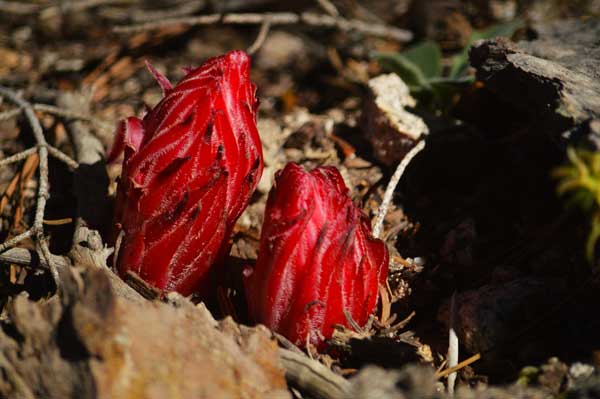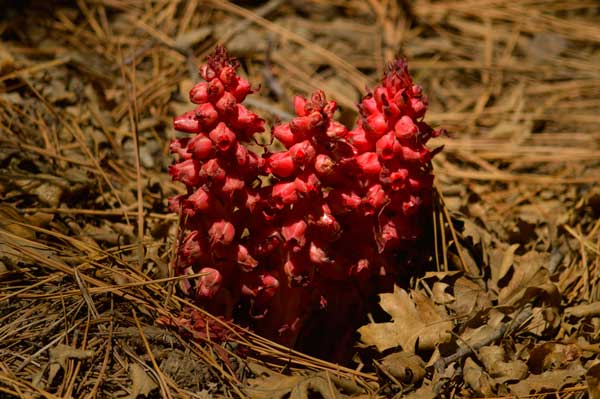The Snow Plant is rumored to have been a favorite plant of John Muir. I, too, share that fascination with this plant/parasite, not just for its bizarre appearance, but also for its interesting process of acquiring nutrients.
 To start, the plant is distinguishable by its physical characteristics. Snow Plants have often been described by my students as, “Red Pinecones” or “Red Christmas Trees”. They appear as fleshy red cones comprised of bulbous red flowers, and most that I’ve seen vary in size from a couple of inches to almost a foot in height (though they can grow up to 20 inches tall). They contain not a single speck of green because they don’t actually contain chlorophyll!
To start, the plant is distinguishable by its physical characteristics. Snow Plants have often been described by my students as, “Red Pinecones” or “Red Christmas Trees”. They appear as fleshy red cones comprised of bulbous red flowers, and most that I’ve seen vary in size from a couple of inches to almost a foot in height (though they can grow up to 20 inches tall). They contain not a single speck of green because they don’t actually contain chlorophyll!
So even though Snow Plants are classified as plants, they don’t actually photosynthesize. Bizarre? Indeed. Intriguing? Of course.
 Let’s start from the beginning. Pine trees, specifically Ponderosa and Jeffrey Pines , dominate our region of the San Bernardino National Forest. At the roots of each of these trees exists a crucial symbiotic relationship. Attached to the ends of the Pine roots are networks of mycorrhizal roots – fungal roots comprised of mycelium. These mycorrhizal roots bring water and nutrients to the Pine Tree in exchange for some of the Pine’s photosynthetic byproducts. Ta-Da! Lovely symbiosis achieved!
Let’s start from the beginning. Pine trees, specifically Ponderosa and Jeffrey Pines , dominate our region of the San Bernardino National Forest. At the roots of each of these trees exists a crucial symbiotic relationship. Attached to the ends of the Pine roots are networks of mycorrhizal roots – fungal roots comprised of mycelium. These mycorrhizal roots bring water and nutrients to the Pine Tree in exchange for some of the Pine’s photosynthetic byproducts. Ta-Da! Lovely symbiosis achieved!
 So where does the Snow Plant fit in to all this? We know the Snow Plant does not photosynthesize and does not contain chlorophyll. That’s because it gains its resources by acting as a parasitic third party of mutualism within the symbiotic relationship of the Pine Trees and mycorrhizal roots. The Snow Plant actually feeds on the mycorrhizal roots, and also steals the photosynthetic byproducts given off by the Pine!
So where does the Snow Plant fit in to all this? We know the Snow Plant does not photosynthesize and does not contain chlorophyll. That’s because it gains its resources by acting as a parasitic third party of mutualism within the symbiotic relationship of the Pine Trees and mycorrhizal roots. The Snow Plant actually feeds on the mycorrhizal roots, and also steals the photosynthetic byproducts given off by the Pine!
So it’s a plant, but it doesn’t photosynthesize, and it feeds on fungi…thus sparking my fascination with this so-called producer that functions more like a consumer.
At High Trails Outdoor Science School, we literally force our instructors to write about elementary outdoor education, teaching outside, learning outside, our dirty classroom (the forest…gosh), environmental science, outdoor science, and all other tree hugging student and kid loving things that keep us engaged, passionate, driven, loving our job, digging our life, and spreading the word to anyone whose attention we can hold for long enough to actually make it through reading this entire sentence. Whew…. www.dirtyclassroom.com

Comments are closed.